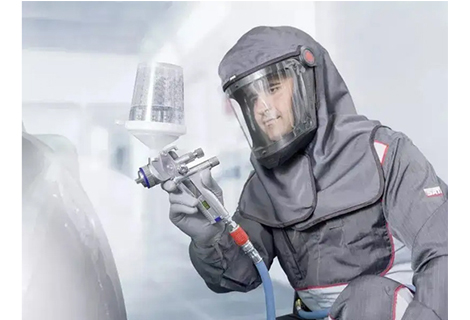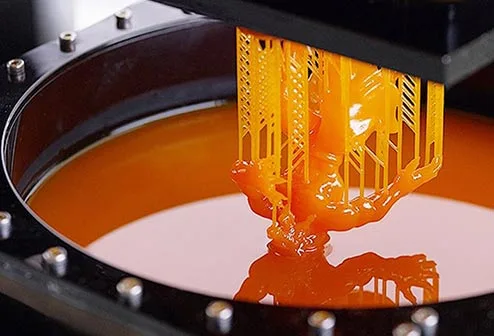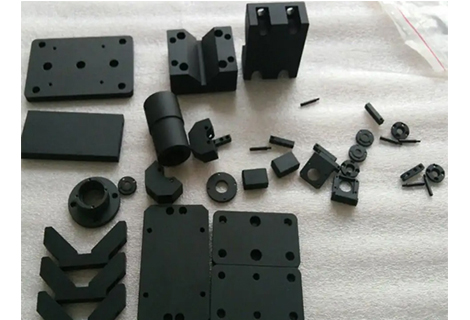Materials scientists like to give their creations complicated names. Polyethylene terephthalate (a form of polyester). Acrylonitrile butadiene styrene (this opaque thermoplastic is better known as ABS). These are just two examples of the thousands of polymers in use today. Many of them have fundamentally changed our lives. However, one type of polymer - with a less unwieldy name - has been around much longer than its polysyllabic counterparts. It's durable, flexible, temperature-resistant, biocompatible in many cases, and suitable for a variety of manufacturing processes, including injection molding and 3D printing. What's it called? It's probably best known to you by the more common name of rubber or caoutchouc.
Rubber or caoutchouc is the stuff that tires, engine hoses and more are made of - but here we specifically mean silicone rubber, which is technically a viscoelastic (short for viscous and elastic) polymer. If we compress this term a bit more, we get elastomer. Elastomers are tough and (usually) flexible, and come in a wide range of grades with high-quality, mechanical, chemical, and optical properties. Richconn offers the following types of elastomeric materials:
| Injection molding | 3D printing |
|---|---|
| LSR | digital photopolymers |
| LSR (fluorosilicone) | TPU (also for injection molding) |
| LSR (Optical) | TPE/TPV |
| TPU (also for 3D printing) |
If you've ever mixed two-part epoxy adhesive for small household repairs, you already know how parts are made from liquid silicone (LSR). Using similar (but in some ways completely different) machinery to injection molding with plastic, LSR injection molding involves pressing equal parts of a chemical catalyst with liquid silicone into a cooled mixing chamber. From here, the material is injected into the mold cavity, which in the case of LSR is heated to accelerate the vulcanization process.
The design rules of LSR molding are very lenient. Concerns about wall thicknesses, taper angles, undercuts and corner radii can largely be ignored. That's because LSR has the consistency of water when it enters the mold - there are no problems with sinks, strand lines, and voids at sharp corners or around deep ribs (assuming the mold has been properly sealed and vented). Ejection of parts is also not a problem - LSR parts generally remain flexible enough to pull from even the most straight-walled molds. The only thing developers need to worry about is flash - because LSR has such a low viscosity, clean and consistent parting lines should be used wherever possible.
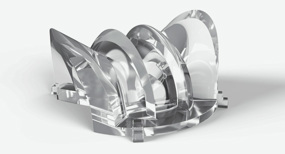
This transparent part for a high-power silicone LED fog light was injection molded with liquid silicone (LSR) for an automotive supplier.
Two types of LSR are available from Richconn. All adhere to the same basic design rules, but have quite different properties:
1. LSR-The Elastosil LR 3003 series is available in four hardness grades from 30 to 70 Shore A and, like most LSRs, combines well with pigments. Suitable applications include electrical automotive parts, seals for the food industry and wherever a flexible, durable and temperature-resistant polymer is needed.
2. LSR (optical) - Want to make a clear but durable lens or other transparent part? Many molders probably reach for polycarbonate first, but optical LSR is far more injection moldable and has better optical properties, surpassed only by glass. It is also biocompatible and among the hardest LSRs, with a hardness of 72 Shore A.
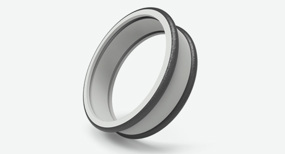
Component consisting of the combination of different flexible materials.
TPE and TPV materials are regularly used for injection-molded elastomer parts, but are most commonly used in dual-material injection molding processes, such as 2K injection molding. For example, if you are ready to take your PolyJet prototype (3D printing) to the next stage of development, Richconn offers numerous grades of elastomeric materials, all of which are part of the TPE/TPV (thermoplastic elastomer/thermoplastic vulcanizate) family. For example, Santoprene 111-45 TPV has excellent fatigue resistance and is a good choice for smartphone covers. Similarly, Santoprene 101-73 is well suited for steering column boots and speaker rings.
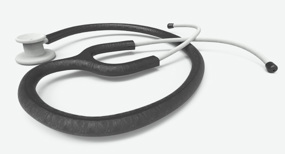
Stethoscope made with the 3D printing process
Among thermoplastic elastomers, Versaflex OM1040X-1 offers a soft feel and excellent aesthetic appearance (can be colored) and adheres well to polycarbonate and ABS, making it a good choice for grip surfaces on medical devices. Another dyeable TPE is Versaflex OM 6240-1, known for its affinity for nylon. Then there's Hytrel 3078, which is considered the Duracell bunny of elastomers thanks to its higher pliability and flexibility compared to standard rubber materials.
Design recommendations for all these materials fall somewhere between "almost anything goes" for LSR and those for conventional thermoplastics. When in doubt, load your CAD model into Richconn' automated quoting system and pay close attention to the "Design for Manufacturability" (DFM) analysis provided afterwards.
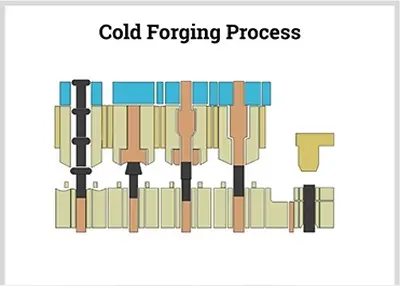 When to Use the Cold Heading ProcessOctober 19, 2023As a professional machining manufacturer, we use the most appropriate machining process to precision machine products and reduce customers' purchasing costs and production time. Precision casting, forging, and profile machining are all very common. In addition cold heading, oil extrusion and other processes are also often used.view
When to Use the Cold Heading ProcessOctober 19, 2023As a professional machining manufacturer, we use the most appropriate machining process to precision machine products and reduce customers' purchasing costs and production time. Precision casting, forging, and profile machining are all very common. In addition cold heading, oil extrusion and other processes are also often used.view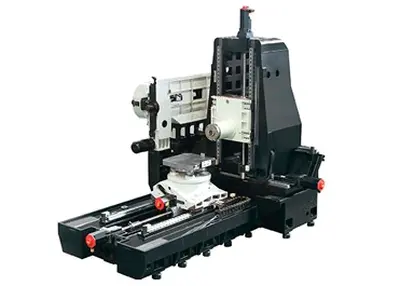 4 Axis CNC Machining: The Definitive Guide 2023August 29, 2023CNC machining is a widely used manufacturing process that involves the use of computer-controlled machines to create precise and complex parts from various materials. CNC machines can operate on diffe...view
4 Axis CNC Machining: The Definitive Guide 2023August 29, 2023CNC machining is a widely used manufacturing process that involves the use of computer-controlled machines to create precise and complex parts from various materials. CNC machines can operate on diffe...view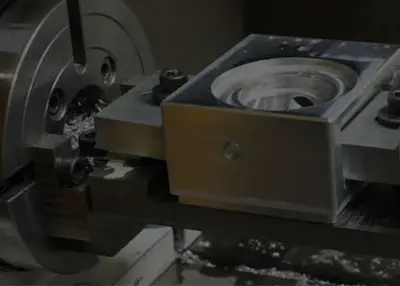 The Ultimate Guide on Aluminum Die Casting 2024August 2, 2023Nowadays, aluminum die casting is widely used in various industries like automotive, industrial, and telecommunications. It’s often used to produce electrical, hydraulic, lighting components, etc. No...view
The Ultimate Guide on Aluminum Die Casting 2024August 2, 2023Nowadays, aluminum die casting is widely used in various industries like automotive, industrial, and telecommunications. It’s often used to produce electrical, hydraulic, lighting components, etc. No...view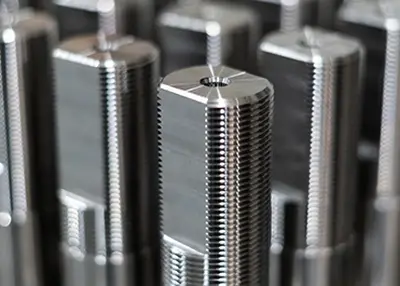 Drill and Tap Specification ChartNovember 17, 2023In CNC machining, the usual process is to use a drill bit to drill a hole in the workpiece and then use a tap of the appropriate size to cut the desired threads in the hole. This ensures that the threads match the design requirements and can ensure that the threads fit correctly with other components.view
Drill and Tap Specification ChartNovember 17, 2023In CNC machining, the usual process is to use a drill bit to drill a hole in the workpiece and then use a tap of the appropriate size to cut the desired threads in the hole. This ensures that the threads match the design requirements and can ensure that the threads fit correctly with other components.view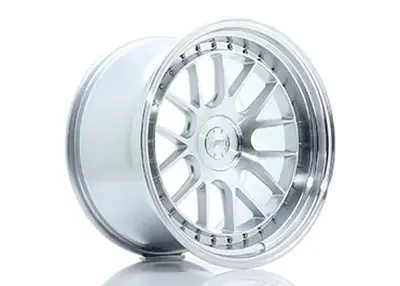 CNC Machining and Machined Wheels: Elevating Automotive ExcellenceNovember 7, 2023Are you ready to delve into the intricate world of CNC machining and its remarkable connection with machined wheels? As an automotive enthusiast and CNC machining professional, I'm thrilled to guide you through this comprehensive exploration of the dynamic interplay between precision engineering and high-performance wheels. Let's roll!view
CNC Machining and Machined Wheels: Elevating Automotive ExcellenceNovember 7, 2023Are you ready to delve into the intricate world of CNC machining and its remarkable connection with machined wheels? As an automotive enthusiast and CNC machining professional, I'm thrilled to guide you through this comprehensive exploration of the dynamic interplay between precision engineering and high-performance wheels. Let's roll!view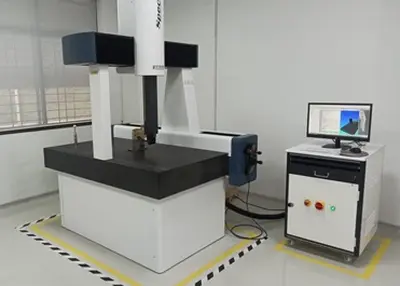 What Is a CMM Machine: Components, Uses, and BenefitsMarch 15, 2024Here is a thorough introduction to CMM machines from components, uses to benefits. Let’s have a deeper look and choose the best CMM service for your projects.view
What Is a CMM Machine: Components, Uses, and BenefitsMarch 15, 2024Here is a thorough introduction to CMM machines from components, uses to benefits. Let’s have a deeper look and choose the best CMM service for your projects.view
 EN
EN
 ru
ru 
